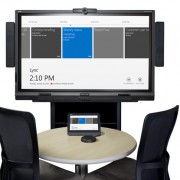Cloud will open video conferencing to SMEs
Cloud or on-premise: how do I choose a video conferencing solution for my business? Deirdre Cashion finds out.
According to research conducted by O2, one third of Irish organisations are interested in or will adopt video conferencing in the near future. This mirrors a growing trend in Europe where more organisations, public and private are subsuming video into their business operations.
Video conferencing solutions have enjoyed widespread adoption among larger organisations for some time now with a market perception, right or wrong, that these systems were simply beyond the financial and technical reach of their smaller counterparts.
But that’s set to change as cloud-based, managed video services start to gain real traction in the Irish market, particularly with cash-strapped small businesses.
“It’s still fairly early days with regards to managed video conferencing services with a 90:10 split between on-premise/cloud but it definitely has potential to take off very soon, not least because of the commercials involved,” according to Adam Grennan, country manager with Cisco Ireland.
“It could be cost-prohibitive for a 50-user organisation to purchase its own conferencing components and that’s where a shared hosted model makes sense,” he said.
Companies can simply rent or buy the units and with a simple, fixed and low-cost monthly subscription fee receive a reliable, secure and fully supported high definition video experience.
“Hosted offerings like these reduce the cost of entry for SMEs to enable them to compete on an even keel with large enterprises and will really enhance the growth of business-to-business video,” said Grennan.
Alan Brown, business director with O2 agrees.
“Cloud-based solutions are becoming increasingly popular due to the ability to connect from any mobile device, the low-cost subscription model inherent in cloud solutions, and the easy transition from consumer cloud solutions to their business equivalents,” he said.
“Similar to what we have seen in the hosted mail market, I would expect larger companies to move to a hybrid on-premise/cloud model and move to a purer cloud model as they gain confidence in the security and reliability of cloud-based video conferencing.”
In the belief that smaller businesses are more likely to make the leap directly to a cloud-based solution to benefit from cost, mobility, and accessibility advantages, O2 recently launched a low-cost suite of cloud-based digital services that includes video conferencing and collaborative tools.
Its business-class, group video solution, Spontania, provides video conferencing over IP to any device including tablet and smartphone and boasts high end functionality with instant messaging and whiteboard functionality built-in.
With the basic package starting at €49 per month for five users on a 30-day rolling contract, it’s a price-point that’s sure to appeal to companies looking to integrate video to their operations in a cost-effective way.
Cisco’s Grennan sees its Webex offering as great way for organisations to trial video with a low cost of entry.
“If documents don’t need to be shared, Webex can be used as a pure audio/video conferencing solution,” he said. “Meetings can be recorded and listened/watched at a later stage. And as Webex is available as an app for download on all major smartphones and tablets, users won’t miss a thing when on the move.”
The current economic climate is forcing all businesses to do more with less. Video conferencing could be one small bullet in the financial arsenal to help win the war against spiralling operational costs.









Leave a Reply
Want to join the discussion?Feel free to contribute!